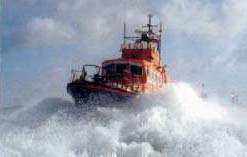Great Yarmouth History
Great Yarmouth and Gorleston-on-Sea Lifeboats
????-1888 Refuge
1889-1939 Elizabeth Simpson
In 1888 a private lifeboat Refuge capsized in Gorleston harbour mouth with the loss of all but 3 of her crew. This tragedy was witnessed by Miss Elizabeth Simpson Stone who donated £500 to the Gorleston Volunteer Lifeboat Association to help replace the Refuge. In 1889, the replacement lifeboat, named Elizabeth Simpson was launched and along with previous private lifeboats was housed in the Volunteer Lifeboat Shed located along Brush Quay. The Elizabeth Simpson being a private lifeboat was not owned or operated by the RNLI but was manned by volunteers from the Rangers Beach Company of Gorleston. During her lifetime, her crews were credited with saving over 441 lives in 119 launchings and without the loss of any crew member.
1892-1921 Mark Lane
The Mark Lane was operated under sail and was donated to the RNLI by the Stock Exchange Lifeboat Fund in 1890. On being tranferred from Lowestoft in 1892 the boat's name was changed from Stock Exchange to Mark Lane. Lifeboat Mark Lane's crews saved 484 lives in 298 launchings.
1894-1923 Leicester
The City of Leicester Lifeboat Fund paid for the Leicester which was money well spent as she saved 89 lives in 72 launchings.
1903-1908 James Stevens No.3
Built in 1898 this was the second steam lifeboat to serve at Great Yarmouth and Gorleston-on-Sea. She had a single propellor and was designed to be ready to steam, immediately, at all times. Only six steam driven lifeboats were built. The James Stevens No.3 finished her days in Holyhead, when in 1928, she was finally withdrawn from service as the last surviving steam driven lifeboat.
1921 John and Mary Meiklam of Gladswood
1921-1939 Agnes Cross (Lowestoft)
1922-1924 Kentwell
The year 1921 saw the first diesel engine lifeboat to appear at a Norfolk lifeboat station which was the John and Mary Meiklam of Gladswood which was assigned to the Gorleston station. The Coxswain and crew refused to accept the lifeboat because of problems deciding on an assistant mechanic. Lowestoft benefitted because of this dispute as the John and Mary Meiklam of Gladswood was transferred to Lowestoft, a move made permanent in May 1922 when the boat was renamed Agnes Cross.
In 1922 the sailing lifeboat Kentwell was transferred to Gorleston from Lowestoft where she had served from 1905. In October 1922 she took part in the rescue of the crew of the S.S Hopelyn which ran aground on Scroby Sands, although she was unsuccessful in her efforts to get the crew of 24 from the S.S. Hopelyn to safety. The crew were eventually rescued by the Lowestoft lifeboat Agnes Cross which also attended the rescue. Coxwsain Swan of the Lowestoft boat and Coxswain Fleming of the Gorleston boat were both both awarded the RNLI's Gold Medal for their exemplary conduct during this rescue.

1924-1939 John and Mary Meiklam of Gladswood
Another twist in the John and Mary Meiklam of Gladswood story.
The lifeboat H.F Bailey was transferred to Gorleston in 1924 as it was thought to be
unsuitable for work in Cromer's waters. At this time lifeboats were still open decked with no
protection for the crews who were exposed to the elements for hours on end and yes,
H.F Bailey was renamed the John and Mary Meiklam of Gladswood. From 1939 until
1946 the John and Mary Meiklam of Gladswood was moth-balled in the RNLI reserve fleet.
She was then sold to British Rail Ferries for use as a harbour boat at Fishguard. In 1986 she
came home to Gorleston to be restored to her former glory. The real glory was in the 211
lives saved in 155 launchings by her gallant crews.
1939-1967 Louise Stephens
The Louise Stephen's arrival at Gorleston was delayed for a year, owing to a faux pas during the construction of the slipway which was built six inches too high. This resulted in the John and Mary Meiklam of Gladswood being retained until the error was rectified. The christening of the Louise Stephens, which was planned for September 1939, never took place owing to the start of WWII. This lifeboat was literally in a class well, sub-class, of its own as it could only be launched from the slipway at Gorleston.
1967-1980 Khami
The unsual name for this boat was chosen by Mr and Mrs T.G. Bedwell who donated the money for her purchase, it is a place in Zimbabwe. This boat was built by Brooke Marine of Lowestoft and was a 44-foot Waveney class boat built for operation at high speed, in all weathers. Of course the all weather part of the brief has been occurring since there have been lifeboats. Khami was involved in a dramatic rescue on 13th December 1974 when 6 people were plucked to safety from the M.V. Biscaya in a force 9 gale. Coxswain Jack Bryan received a bar to his Bronze medal for this rescue.
1980-1996 Barham
Another 44-foot Waveney class boat for use at Gorleston. This lifeboat was named after H.M.S. Barham which was sunk in November 1941. Mr Colin Stringfellow who lost his only brother in H.M.S. Barham had left a legacy for the purchase of this boat. A fitting memorial to his brother and his brother's shipmates.
1996- Samarbeta
The Samarbeta was purchased by the RNLI after being given cars by Volvo Car UK Limited, which were then raffled.
The legacies left by Elizabeth Longman and Constance Rogers were also put towards the purchase of this boat.
Sarmarbeta is Swedish for "Working Together"